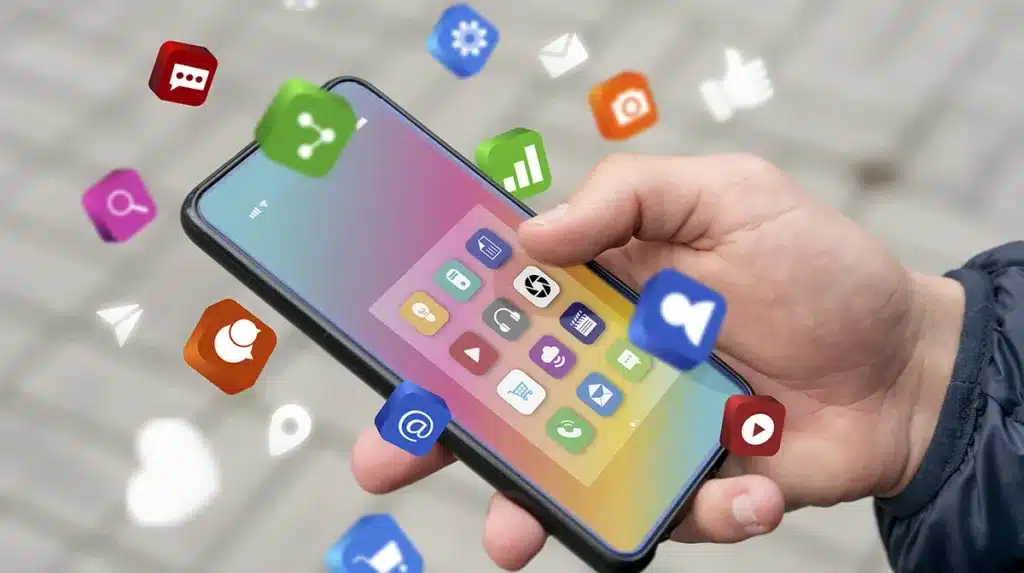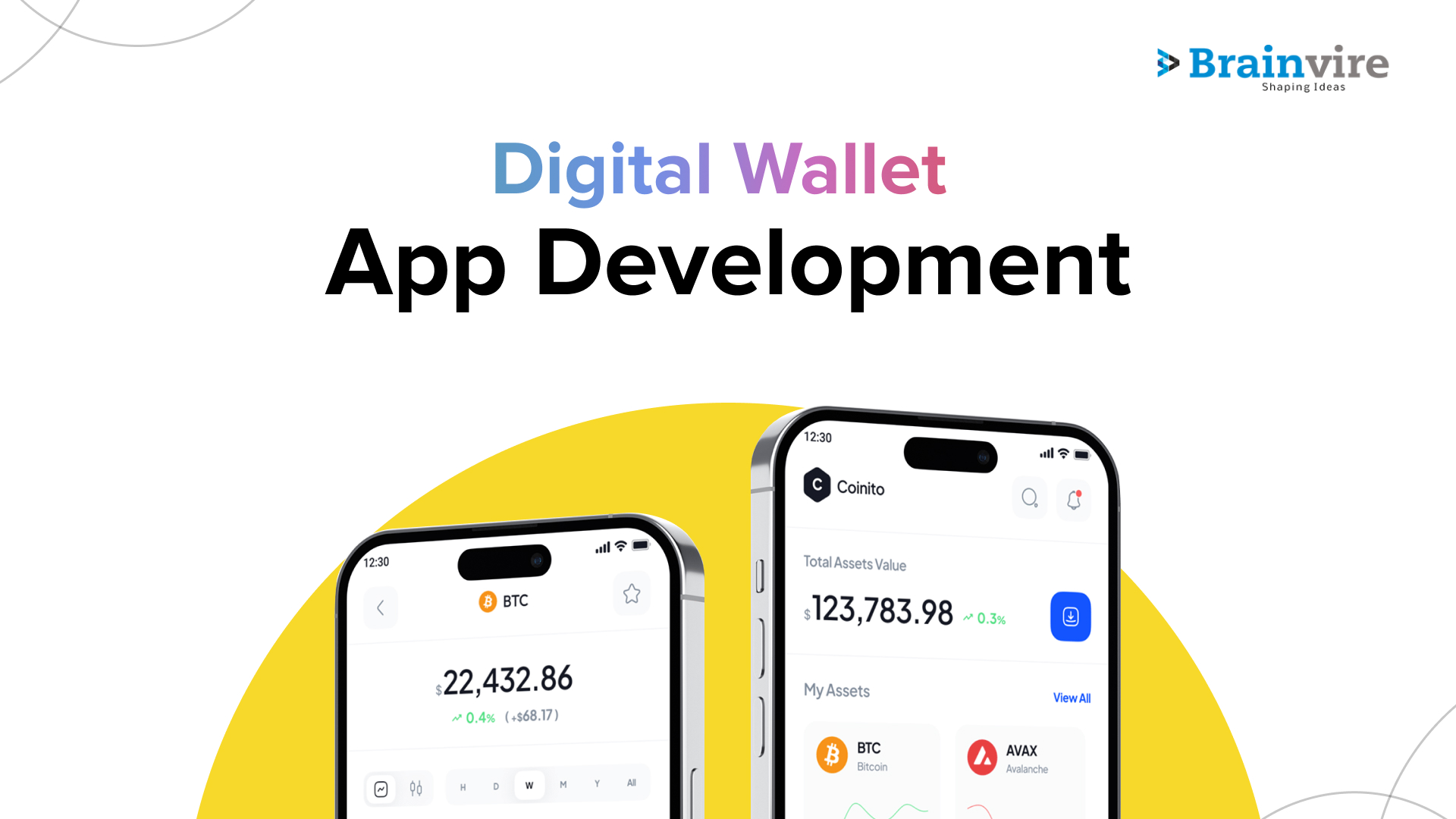Gone are the days when the smartphone was a mere communication device; on the contrary, over the last few years, it has evolved into a ubiquitous personal assistant, entertainment hub, and commerce portal. At the heart of this transformation lie mobile applications development, offering a more dynamic, pervasive, and intelligent landscape than ever before.
In fact, in today’s times, mobile apps have become indispensable digital companions that shape our daily routines, connect us to the world, and increasingly, facilitate our lives. As we navigate 2025, the mobile app landscape continues its dizzying ascent, ensuring that from the moment we wake up to the last scroll before bed, our smartphones, and the apps nestled within them, are our constant companions.
The digital world is evolving at a breakneck pace, and staying ahead means deciphering the data that shapes our interactions. For businesses, developers, marketers, and everyday users, understanding these shifts isn’t just insightful – it’s absolutely critical. In this blog, we will dive deep into 15 underlying trends and statistical truths that reveal the true scope of mobile app dominance in 2025.
Measuring App Success: Downloads and Revenue
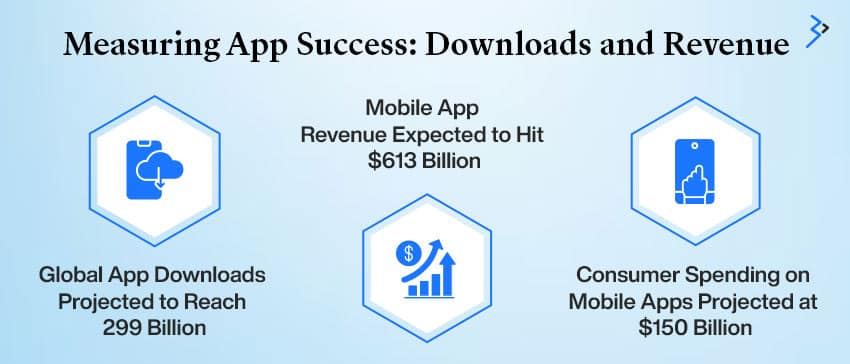
The sheer volume of app activity in 2025 is staggering, which speaks volumes about the mobile app’s position as the primary digital interface. Let’s check out some statistics below to further elucidate this:
1. Global App Downloads Projected to Reach 299 Billion: No price for guessing that this colossal figure signifies a continuing upward trend in app adoption. It speaks to the ongoing global smartphone penetration, particularly in emerging markets, and the constant influx of new, innovative applications catering to diverse needs. For developers, this means a vast addressable market, but also an intensely competitive one, so apps need a smart plan and a focus on users to really stand out.
2. Mobile App Revenue Expected to Hit $613 Billion: This huge income prediction shows that different ways apps make money—like buying things inside apps, subscriptions, and ads—really work. It also means there’s a lot of money to be made for businesses that can create and grow popular apps people love using.
3. Consumer Spending on Mobile Apps Projected at $150 Billion: This number really shows how much money users are directly spending on apps. It means people are more and more willing to pay for extra features, no ads, and digital content. This suggests there is a growing willingness amongst considers to pay for premium features, ad-free environments, and digital content. So, the app market is showing clear signs of maturity, where users see the value in apps and are happy to pay for it.
Read More – Building Cross-Platform Mobile Apps with React Native: A Complete Guide
How Apps Are Woven into Our Daily Lives: Time Spent and User Engagement
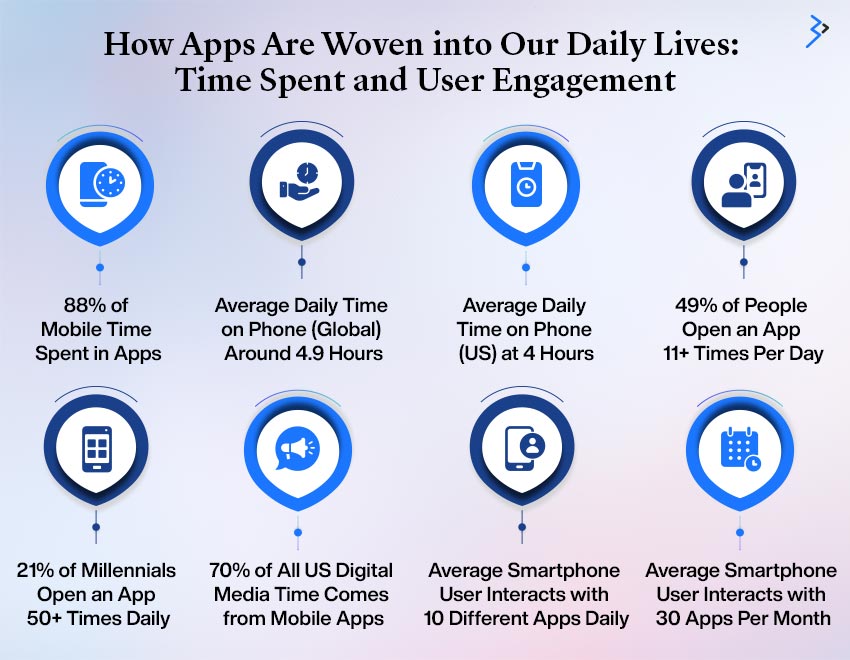
Beyond downloads and dollars, the true measure of an app’s impact lies in how deeply it integrates into our daily lives. In 2025, mobile apps are not just present; they are the beating heart of our digital lives.
- 88% of Mobile Time Spent in Apps, Not Browsers: This is a foundational statistic, shows apps are much more popular than simply browsing websites on your phone. For businesses, this re-emphasizes how critical it is to have a strong app plan. If you want to capture consumer attention and loyalty on mobile, you need to be where they spend most of their time – inside apps.
- Average Daily Time on Phone (Global) Around 4.9 Hours, with 89% in Apps: Did you know that the global smartphone user spends nearly five hours daily on their device? And what’s more, the vast majority of that time is devoted to apps. This isn’t just about passive consumption; it encompasses everything from communication and productivity to entertainment and learning. It’s a clear indication that apps are interwoven with our daily routines.
- Average Daily Time on Phone (US) at 4 Hours and 2 Minutes: While slightly lower than the global average, the US still demonstrates a significant daily engagement with mobile internet via smartphones. This consistent, high-level engagement opens up immense opportunities for hiring mobile app developers and businesses to connect with a highly attentive audience.
- 49% of People Open an App 11+ Times Per Day: This metric speaks to the habitual nature of app usage. It’s not just about long sessions, but frequent, often brief, interactions throughout the day. Apps that provide quick value, notifications, and seamless access tend to encourage this kind of high-frequency engagement.
- 21% of Millennials Open an App 50+ Times Daily: Millennials, a crucial demographic with significant purchasing power, are leading the charge in hyper-frequent app engagement. This indicates how this generation relies heavily on apps for various aspects of their lives. Understanding their unique app usage patterns is vital for targeting this segment effectively.
- 70% of All US Digital Media Time Comes from Mobile Apps: This statistic further solidifies the mobile app’s position as the primary channel for digital media consumption in the US. From streaming video and music to social media and news, apps have become the go-to platforms, overshadowing desktops and even mobile web browsers.
- Average Smartphone User Interacts with 10 Different Apps Daily: While the total number of apps on a phone can be extensive, users typically cycle through a core set of around ten apps daily. This highlights the importance of being one of those “daily essentials” – a must-have app that provides consistent, undeniable value.
- Average Smartphone User Interacts with 30 Apps Per Month: Expanding the scope to a monthly view, users engage with a broader variety of apps. This suggests that while daily usage might be concentrated, there’s still room for specialized or occasional-use apps to carve out a niche and remain relevant to the user.
Read More – Top SAST Tools for Mobile App Security Testing
Driving Factors and Emerging Landscapes
Beyond the raw numbers, several underlying trends are shaping the mobile app landscape in 2025.
- Social Media and Entertainment Apps Account for Over 40% of Total Mobile App Usage: This statistic underscores the significant role the internet plays in our socializing and entertainment activities. Apps like TikTok, Instagram, and streaming services dominate our screen time because they create such captivating experiences. Other companies should learn from how these leaders make their content addictive and personalized.
- Mobile Commerce Volume Expected to Surpass $4 Trillion in 2025, with Over 60% of Shoppers Favoring Mobile Apps for Purchases: Shopping on phones, called m-commerce, is definitely growing, and apps are leading the way. People like dedicated shopping apps more than regular mobile websites. Why? Apps give you a better, more personal, and secure way to shop. Quick checkout, loyalty points, and personalized product ideas are all important features that drive this trend.
- Estimated 4.69 Billion People Own a Smartphone Worldwide in 2025: All these users around the world are the base of the app economy. The continued growth in smartphone ownership, especially in developing nations is bound to be followed by a sustained expansion of the mobile app market for years to come. Developers and app makers must consider the increasing diversity in user needs, languages, and cultural contexts.
- AI Becoming Central to Mobile App Experiences: Artificial Intelligence (AI) isn’t just a future idea anymore; it’s already changing how we use apps. AI powers hyper-personalized user experiences, from tailored content recommendations to predictive analytics that anticipate user needs. It revolutionizes ad targeting, making ads more relevant and less intrusive. Furthermore, Artificial Intelligence streamlines creative production, enabling faster and more efficient app development. A report from Gartner suggests that by 2025, 70% of new applications in 2025 will be developed using low-code or no-code technologies, often incorporating AI. This signifies a democratized development landscape where innovation can occur at an unprecedented pace. We’ll see many more special, niche apps as a result. While this might split our attention, it also creates new chances for very specific solutions.
Key Insights and the Road Ahead
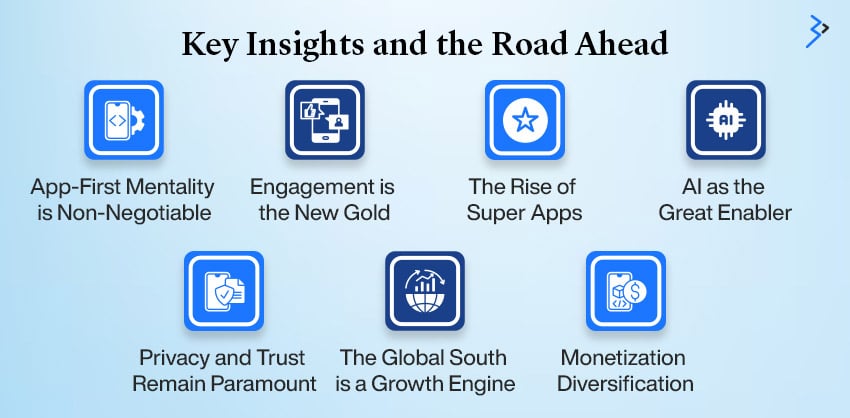
These 15 statistics collectively paint a picture of a vibrant, expanding, and increasingly intelligent mobile app ecosystem. Here are some overarching insights:
- App-First Mentality is Non-Negotiable: For any business aiming to reach and engage modern consumers, an app-first strategy is no longer optional. It’s the primary battlefield for digital attention and revenue.
- Engagement is the New Gold: While downloads are important, sustained user engagement is the ultimate currency. Apps that can consistently deliver value, personalize experiences, and foster habitual usage will thrive.
- The Rise of Super Apps: The convergence of multiple services within a single app (the “super app” model) is gaining traction, driven by user demand for convenience and efficiency. This could lead to intense competition for dominant app platforms.
- AI as the Great Enabler: AI is transforming every facet of the app lifecycle, from development and design to user experience and monetization. Developers who leverage AI effectively will gain a significant competitive advantage.
- Privacy and Trust Remain Paramount: With increasing data collection and personalization, user concerns about privacy will only grow. Apps that prioritize data security and transparency will build greater trust and loyalty.
- The Global South is a Growth Engine: Emerging markets with rapidly increasing smartphone penetration are fueling much of the app download growth. Localization and understanding diverse cultural nuances will be crucial for global success.
- Monetization Diversification: While ads and in-app purchases remain strong, subscription models, freemium, and even blockchain-based monetization are evolving, offering developers a wider array of revenue streams.
Read More – The Future of Mobile App Development with Java: A Comprehensive Guide
The App Evolution Continues: Embracing the Future
So, what do these app stats really tell us? They show that the mobile world never stops changing! From how we connect and shop to how AI makes apps smarter and easier to build, the future of mobile is all about being personal, convenient, and incredibly innovative. In conclusion, 2025 is set to be a landmark year for mobile apps, characterized by unprecedented scale, deeper integration into daily life, and transformative technological advancements, particularly in AI.
For anyone looking to thrive in this space, staying curious and ready to adapt isn’t just a good idea—it’s the only way to keep up with the apps that are shaping our lives. The “app-ocalypse” isn’t a disaster; it’s a revolution, and we are all living within its ever-expanding digital embrace.
Related Articles
-
How Mobile Applications Are Game-Changing For Insurers?
Well said, Most of us forget to take our wallet, but not the mobile phones.” Mobile phones have become an integral part of our lives and its number is growing
-
Innovative Trends In Digital Wallet App Development For 2023
Innovative digital wallet app development trends are reshaping how people conduct transactions today. As 2023 approaches, businesses increasingly hire mobile app developers to create user-friendly digital wallets that exploit emerging
-
Modern Day Norms – Mobile Computation and Our Synched Routine
When we talk about mobile technology, it not only covers social media chatting or emailing or clicking and editing snaps. Apart from all this, mobile technology has a huge impact on

